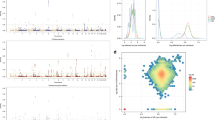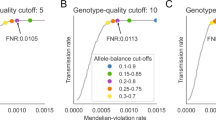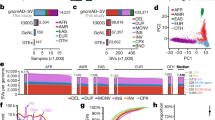Abstract
The central goal of human genetics is to understand the inherited basis of human variation in phenotypes, elucidating human physiology, evolution and disease. Rare mutations have been found underlying two thousand mendelian diseases; more recently, it has become possible to assess systematically the contribution of common SNPs to complex disease. The known role of copy-number alterations in sporadic genomic disorders, combined with emerging information about inherited copy-number variation, indicate the importance of systematically assessing copy-number variants (CNVs), including common copy-number polymorphisms (CNPs), in disease. Here we discuss evidence that CNVs affect phenotypes, directions for basic knowledge to support clinical study of CNVs, the challenge of genotyping CNPs in clinical cohorts, the use of SNPs as markers for CNPs and statistical challenges in testing CNVs for association with disease. Critical needs are high-resolution maps of common CNPs and techniques that accurately determine the allelic state of affected individuals.
This is a preview of subscription content, access via your institution
Access options
Subscribe to this journal
Receive 12 print issues and online access
$209.00 per year
only $17.42 per issue
Buy this article
- Purchase on Springer Link
- Instant access to full article PDF
Prices may be subject to local taxes which are calculated during checkout



Similar content being viewed by others
References
Inoue, K. & Lupski, J.R. Molecular mechanisms for genomic disorders. Annu. Rev. Genomics Hum. Genet. 3, 199–242 (2002).
Lupski, J. R. Genomic rearrangements and sporadic disease. Nat. Genet. 39, S43–S47 (2007).
Padiath, Q.S. et al. Lamin B1 duplications cause autosomal dominant leukodystrophy. Nat. Genet. 38, 1114–1123 (2006).
Le Marechal, C. et al. Hereditary pancreatitis caused by triplication of the trypsinogen locus. Nat. Genet. 38, 1372–1374 (2006).
Lee, J.A. & Lupski, J.R. Genomic rearrangements and gene copy-number alterations as a cause of nervous system disorders. Neuron 52, 103–121 (2006).
Gonzalez, E. et al. The influence of CCL3L1 gene-containing segmental duplications on HIV-1/AIDS susceptibility. Science 307, 1434–1440 (2005).
Aitman, T.J. et al. Copy number polymorphism in Fcgr3 predisposes to glomerulonephritis in rats and humans. Nature 439, 851–855 (2006).
Yang, Y. et al. Gene copy-number variation and associated polymorphisms of complement component C4 in human systemic lupus erythematosus (SLE): low copy number is a risk factor for and high copy number is a protective factor against SLE susceptibility in European Americans. Am. J. Hum. Genet. 80, 1037–1054 (2007).
Fanciulli, M. et al. FCGR3B copy number variation is associated with susceptibility to systemic, but not organ-specific, autoimmunity. Nat. Genet. 39, 721–723 (2007).
Stranger, B.E. et al. Relative impact of nucleotide and copy number variation on gene expression phenotypes. Science 315, 848–853 (2007).
de Bakker, P.I. et al. Efficiency and power in genetic association studies. Nat. Genet. 37, 1217–1223 (2005).
Pe'er, I. et al. Evaluating and improving power in whole-genome association studies using fixed marker sets. Nat. Genet. 38, 663–667 (2006).
Altshuler, D. et al. An SNP map of the human genome generated by reduced representation shotgun sequencing. Nature 407, 513–516 (2000).
Reich, D.E., Gabriel, S.B. & Altshuler, D. Quality and completeness of SNP databases. Nat. Genet. 33, 457–458 (2003).
Hinds, D.A. et al. Whole-genome patterns of common DNA variation in three human populations. Science 307, 1072–1079 (2005).
International HapMap Consortium. A haplotype map of the human genome. Nature 437, 1299–1320 (2005).
Sebat, J. et al. Large-scale copy number polymorphism in the human genome. Science 305, 525–528 (2004).
Iafrate, A.J. et al. Detection of large-scale variation in the human genome. Nat. Genet. 36, 949–951 (2004).
Sharp, A.J. et al. Segmental duplications and copy-number variation in the human genome. Am. J. Hum. Genet. 77, 78–88 (2005).
Tuzun, E. et al. Fine-scale structural variation of the human genome. Nat. Genet. 37, 727–732 (2005).
Conrad, D.F., Andrews, T.D., Carter, N.P., Hurles, M.E. & Pritchard, J.K. A high-resolution survey of deletion polymorphism in the human genome. Nat. Genet. 38, 75–81 (2006).
Hinds, D.A., Kloek, A.P., Jen, M., Chen, X. & Frazer, K.A. Common deletions and SNPs are in linkage disequilibrium in the human genome. Nat. Genet. 38, 82–85 (2006).
McCarroll, S.A. et al. Common deletion polymorphisms in the human genome. Nat. Genet. 38, 86–92 (2006).
Locke, D.P. et al. Linkage disequilibrium and heritability of copy-number polymorphisms within duplicated regions of the human genome. Am. J. Hum. Genet. 79, 275–290 (2006).
Khaja, R. et al. Genome assembly comparison identifies structural variants in the human genome. Nat. Genet. 38, 1413–1418 (2006).
Redon, R. et al. Global variation in copy number in the human genome. Nature 444, 444–454 (2006).
Zhang, J., Feuk, L., Duggan, G.E., Khaja, R. & Scherer, S.W. Development of bioinformatics resources for display and analysis of copy number and other structural variants in the human genome. Cytogenet. Genome Res. 115, 205–214 (2006).
Eichler, E.E. et al. Completing the map of human genetic variation. Nature 447, 161–165 (2007).
Fiegler, H. et al. Accurate and reliable high-throughput detection of copy number variation in the human genome. Genome Res. 16, 1566–1574 (2006).
McVean, G.A. et al. The fine-scale structure of recombination rate variation in the human genome. Science 304, 581–584 (2004).
Gabriel, S.B. et al. The structure of haplotype blocks in the human genome. Science 296, 2225–2229 (2002).
Lieberfarb, M.E. et al. Genome-wide loss of heterozygosity analysis from laser capture microdissected prostate cancer using single nucleotide polymorphic allele (SNP) arrays and a novel bioinformatics platform dChipSNP. Cancer Res. 63, 4781–4785 (2003).
Zhao, X. et al. An integrated view of copy number and allelic alterations in the cancer genome using single nucleotide polymorphism arrays. Cancer Res. 64, 3060–3071 (2004).
Garraway, L.A. et al. Integrative genomic analyses identify MITF as a lineage survival oncogene amplified in malignant melanoma. Nature 436, 117–122 (2005).
Zhao, X. et al. Homozygous deletions and chromosome amplifications in human lung carcinomas revealed by single nucleotide polymorphism array analysis. Cancer Res. 65, 5561–5570 (2005).
Cohen, J.C. et al. Multiple rare alleles contribute to low plasma levels of HDL cholesterol. Science 305, 869–872 (2004).
Cohen, J.C., Boerwinkle, E., Mosley, T.H., Jr. & Hobbs, H.H. Sequence variations in PCSK9, low LDL, and protection against coronary heart disease. N. Engl. J. Med. 354, 1264–1272 (2006).
Campbell, C.D. et al. Demonstrating stratification in a European American population. Nat. Genet. 37, 868–872 (2005).
Pritchard, J.K., Stephens, M., Rosenberg, N.A. & Donnelly, P. Association mapping in structured populations. Am. J. Hum. Genet. 67, 170–181 (2000).
Price, A.L. et al. Principal components analysis corrects for stratification in genome-wide association studies. Nat. Genet. 38, 904–909 (2006).
Clayton, D.G. et al. Population structure, differential bias and genomic control in a large-scale, case-control association study. Nat. Genet. 37, 1243–1246 (2005).
Lohmueller, K.E., Pearce, C.L., Pike, M., Lander, E.S. & Hirschhorn, J.N. Meta-analysis of genetic association studies supports a contribution of common variants to susceptibility to common disease. Nat. Genet. 33, 177–182 (2003).
Author information
Authors and Affiliations
Ethics declarations
Competing interests
The authors declare no competing financial interests.
Rights and permissions
About this article
Cite this article
McCarroll, S., Altshuler, D. Copy-number variation and association studies of human disease. Nat Genet 39 (Suppl 7), S37–S42 (2007). https://doi.org/10.1038/ng2080
Published:
Issue Date:
DOI: https://doi.org/10.1038/ng2080
This article is cited by
-
The rice pangenome branches out
Cell Research (2022)
-
Genetics of diaphragmatic hernia
European Journal of Human Genetics (2021)
-
Association between IL28B Polymorphisms and Outcomes of Hepatitis B Virus Infection: A meta-analysis
BMC Medical Genetics (2020)
-
A fast-linear mixed model for genome-wide haplotype association analysis: application to agronomic traits in maize
BMC Genomics (2020)
-
Treatment-resistant psychotic symptoms and the 15q11.2 BP1–BP2 (Burnside-Butler) deletion syndrome: case report and review of the literature
Translational Psychiatry (2020)



